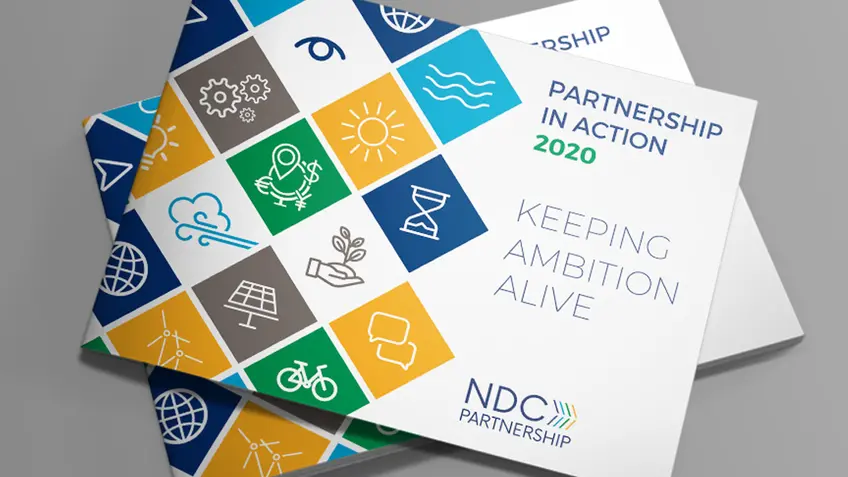PiA 2020: About this Report
This publication reports on the Partnership’s progress in 2020, sharing key examples of country leadership as well as lessons learned on cross-cutting issues. We hope that these offer a real flavor of where Partnership members are making a difference and of the challenges still ahead.
Key Themes
The Partnership supports countries on a wide range of topics according to government priorities. Although these priorities vary, there are key themes that feature in many country requests and on which we share insights.
Mainstreaming Climate Action into Sustainable Development
Countries are integrating climate action into domestic policy, planning, budget, and SDG agendas across government. In the COVID-19 era, this includes using climate action as a basis for economic recovery. This involves many varied actions, and we offer snapshots on how countries are facing up to COVID, health issues, inclusive growth, and adaptation, as well as their efforts to engage youth and make climate action gender responsive.
Financing Climate Action
Countries use Partnership Plans (see How the Partnership Works section) to mobilize climate finance from domestic, international, institutional, and private sector sources. Domestically, ministries are turning NDCs into concrete sectoral investment plans. By identifying clear priorities and bankable projects, governments are paving the way for development partners to tailor climate finance to national needs, as well as sending strong signals to the private sector and financial institutions to increase and accelerate their commitments.
Enhancing NDC Quality and Raising Ambition
Despite the challenges of COVID-19, countries are enhancing their climate targets, plans, and actions in line with the Paris Agreement. The Partnership is delivering support to countries to raise ambition and strengthen NDCs with better analysis and more expansive consultation.
Country Stories
While the issues above are vital across countries, the Partnership’s work is best illustrated by countries taking a systemic approach to cooperation. These country stories show how leading nations have drawn on Partnership support to drive transformative climate action.
At a glance: achievements from the 2018-2020 Work Program
During the less than four years since its founding, the Partnership has made significant progress. Some highlights:
- Thirty Partnership Plans have been developed, harmonizing donor support, providing a mechanism for coordination, and improving the effectiveness of support. These Plans also help countries prioritize and coordinate action.
- Governments across 46 countries have implemented facilitation mechanisms. In some cases, facilitation is managed directly by the government. In 30 cases, the government is supported by embedded facilitators provided by the Partnership. And in some countries, the government has nominated an institutional member to play the role of facilitator. With seven Partnership members’ support, these mechanisms enhance coordination and provide much-needed capacity.
- Forty-eight countries have established or strengthened NDC or Climate Change Sectoral Working Groups at the technical or ministerial levels. These are bringing together different sectoral priorities and perspectives and leading to concrete synergies between sectors to support discrete climate change mitigation and adaptation policies and activities.
- Over USD500 million has been mobilized and disbursed through multiple member-managed NDC financing facilities. Members worked together through consultative processes to plan, program, and disburse resources for a collective impact.
- Through the Climate Action Enhancement Package (CAEP), a total of 63 countries are receiving support to enhance NDC quality, raise climate ambition, and fast-track implementation. This financial and technical support is delivered by 46 partners, with more than USD45.5 million in financial support in less than 12 months, including USD23.8 million disbursed through the Partnership’s Technical Assistance Fund (TAF) and more than USD21.7 million leveraged in co-finance from partners.
- The Economic Advisory Initiative provided early support to 32 countries’ Finance and Planning Ministries to integrate climate in economic recovery plans (see above).
- The Partnership’s Knowledge Portal contains almost 1,000 curated tools and resources contributed by members and non-members across the Climate Toolbox (640), Good Practices Database (252), and Climate Finance Explorer (98), while also providing valuable data on GHG emissions, NDC-SDG linkages, NDC content, and other data tools.
- The internal knowledge management system (kNook) catalogues a unique data set with around 4,300 individual country requests to the Partnership and the support being delivered against them. These data inform regular briefings to all members to analyze trends and fill gaps in support.
- The Partnership has facilitated more than 40 peer exchanges since 2018, engaging more than 2,000 country and institutional participants to share lessons and insights from practical experiences in climate action.
This is a PiA 2020 story: Browse the multimedia version or PDF version.
